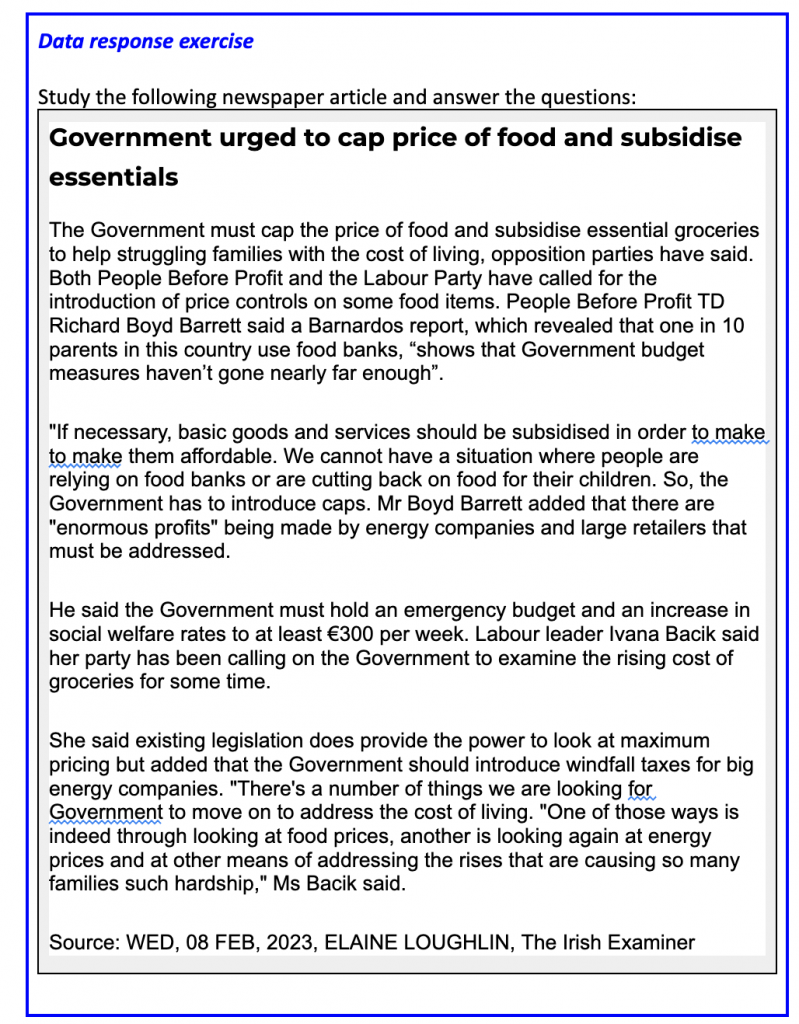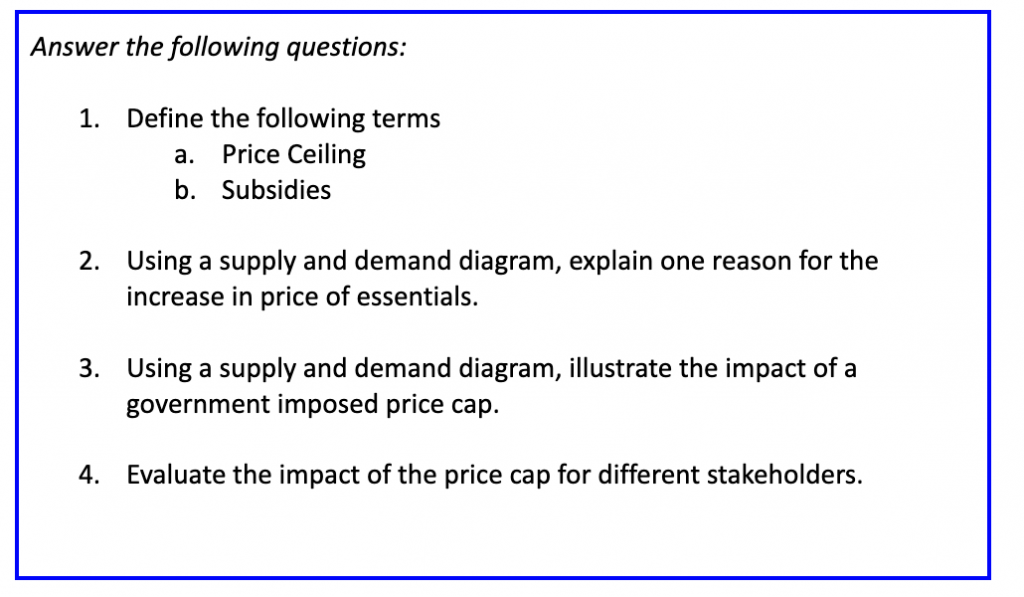You will see government intervention when they try to correct market failure, rent controls in the housing market, price floors for agriculture/alcohol, regulation of oligopolies/monopolies, or anywhere in the national budget (minimum wages/concrete levy). You need to know why the government intervenes and the consequences (positive and negative of that intervention). Therefore, I will include links to some of the government interventions below:
Other ways to intervene in the market is to impose minimum prices (above the market price) or maximum prices (below the market price). See the following.
- Minimum (high) Price Controls
Government sets a minimum price, above equilibrium, which prevents producers from reducing the price below it. (cannot go below the ‘floor’)
Minimum price is set for three reasons:
- To act as a disincentive to consume a good or service
- To attempt to raise incomes for producers for goods and services, such as agricultural products. Perhaps to protect them from high foreign competition.
- To protect workers by setting a minimum wage, to increase disposable income and meet cost of living.
A minimum price for Alcohol
| D – | Discuss: Price Pmin is set above the equilibrium price Pe. |
| E – | Effect: Quantity supply increases (Qe to Q2) and quantity demand decreases (Qe to Q1) |
| R- | Reason: This is because of the law of supply, producers will supply more at a higher price. Quantity demand falls due to the law of demand, as price increases consumers demand less. |
| E – | Equilibrium: This creates excess supply (between Q1 and Q2). |
What impact do Trade Unions have on Wage Rates;
- Minimum wage
Trade Unions aim to safeguard the jobs of their members. They may set minimum wage for a particular occupation, below which no labour will be supplied.
- Restriction on the Supply of Labour
A union may attempt to restrict the supply of labour to an occupation in an effort to keep wages high. Methods used to restrict supply of labour include
- Lengthy and costly training periods
- Restricted opening for trainees
- Difficult exams
- Trade unions unwilling to accept wage reduction
Wages generally increase especially if there is an economic boom and the demand for labour is high. However, during a recession when demand for labour falls, union may be unwilling to accept a cut in wages.
Trade unions negotiate a minimum wage for their workers, this ensures that there is no supply of labour below a certain rate.
Labour market – a minimum wage
- The trade union may negotiate a minimum wage rate: this is set at W. min
- No workers will be supplied below W. min
Impact of minimum wage:
- Excess supply of labour which can lead to unemployment
- Firms substitute labour for capital / machinery.
Wage drift – if the demand for labour is strong the wage rate may rise above the rate negotiated by unions and employers.
Labour hoarding – this is when firms employ labour even though it is unprofitable to do so
Exam Question
Reducing Minimum Wage
Advantages of reducing minimum wage |
Lower labour costs Resulting in continued production and reduced risk of business closure. |
Lower selling prices With production costs falling this may lead to lower consumer prices and increased competition |
Increased demand / protection of jobs The lower wage rate leading to lower prices may lead to increased demand and hence greater demand for workers. Indigenous jobs are protected e.g. jobs in the tourism sector |
Investment stimulus Reduced costs may lead to increased investment by entrepreneurs / increased foreign direct investment. |
Disadvantages of reducing minimum wage |
Reduced standard of living Workers will now receive lower income and so their standard of living will fall |
Workers on lower incomes suffer most If the reduction is confined to those on the minimum wage rate then the burden is not being shared equally within the workforce, which is not equitable |
Discourage employment The reduction may not encourage people to join the workforce/ it may lead to a greater participation in the black economy |
Reduced aggregate demand /spending Lower incomes will reduce spending and so the demand for goods and services may fall resulting in unemployment/less VAT receipts. |
Government intervention: Price ceiling on rent (Maximum Price)
Watch Rent Control:
Newspaper article: Property news
Rent Control diagram
| D – | Discuss: Price Pmax is set below the equilibrium price Pe. |
| E – | Effect: Quantity supply decreases (Qe to Q1) and quantity demand increases (Qe to Q2) |
| R- | Reason: This is because of the law of supply, producers will supply less at a lower price. Quantity demand increases due to the law of demand, as price decreases consumers demand more. |
| E – | Equilibrium: This creates excess demand (between Q1 and Q2). |
Other types of Gov. Intervention
- Help to buy schemes
- Tax on derelict homes
- Plastic bag levy
- Sugar tax
- Carbon emission tax
- Ban on advertising alcohol in public places
- Age restrictions on smoking and drinking
- HSE – positive advertising for health
Advantages of government intervention
- It helps provide fair prices for consumers, especially for essential goods and services. Eg. If the market price is too high, the government can introduce a price ceiling.
- It ensures fair prices for producers/suppliers. Eg. if a market price is too low the government can introduce a price floor that has a guaranteed market price for suppliers.
- |It can discourage consumption / production of demerit goods. Eg. cigarettes and alcohol.
Exam Questions
SEC 2022
SEC 2022
1. 2017 Section B – q 1 b. 20 marks
The average monthly rental price for private residential property in Ireland is €1,078
- Assume the average monthly equilibrium is €1,078. On the diagram, illustrate the effect on the market if the Irish government introduced a rent control that sets a maximum rent at €715
- Discuss the likely economic consequences of such a rent control (ie. Price ceiling on rental costs) on the Irish property market
2. 2018 Section B Q1 a. 25 marks
- Distinguish between a movement along a demand curve and shift in a demand curve
- Explain, using a supply and demand diagram how a market would return to equilibrium following a surplus (excess surplus) in the market
Test your knowledge of balance between markets and intervention


